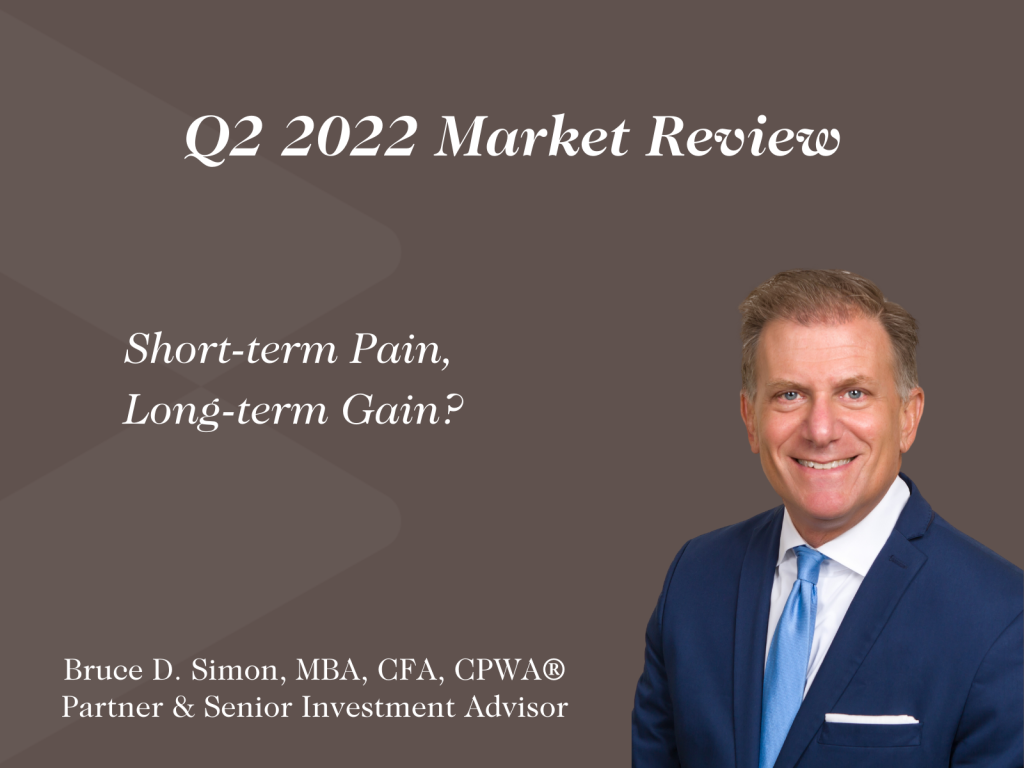Market Recap
Our first quarter market review letter was titled “It Could Have Been Worse”. And the second quarter, in fact, was. It was the worst start to the year for US stocks since 1970.
After the Federal Reserve acknowledged that inflation was to remain a significant problem for the foreseeable future, they implemented a series of aggressive moves to cool the economy. As a result, risk assets experienced painful selloffs in Q2. After a modest decline of -4.6% in the first quarter of 2022, the S&P 500 collapsed -16.8% in Q2, bringing its first-half decline to -21%, breaching the traditional bear market threshold of a 20% peak-to-trough decline. Other geographic regions sustained similar declines, although Chinese stocks (MSCI China) bucked the trend by posting a modest gain.
Bonds also declined in the second quarter, providing little relief for those investors seeking refuge from falling stock prices. The widely followed Bloomberg US Aggregate Bond Index declined -4.7% in the second quarter, bringing its year-to-date loss to -10.3%.
Alone in the winner’s circle so far this year is oil. Buoyed by supply constraints imposed on Russia for its invasion of Ukraine, a popular index of oil prices is up 51% in 2022.
We recognized the heightened risk of a market downturn earlier in the year and encouraged clients who were overextended in equities to reduce their position to their long-term strategic targets. We’ve also maintained a defensive position in fixed income for quite some time, anticipating that the Fed’s zero interest rate policy (ZIRP) would eventually outlive its usefulness. Despite these adjustments, most client portfolios sustained substantial losses in the first half, consistent with declines in the broad market averages.
Outlook and Strategy
While some will bemoan the failure to take corrective action ahead of a protracted downturn (“it was so obvious in hindsight that the market was primed to fall”), the reality is that implementing a preemptive move such as this with success is exceptionally difficult. Factor in the likely tax liability of selling equities after a multi-year run of strong performance and the additional challenge of buying back in before the market has fully recovered. In short, the hurdles are extraordinarily high to consistently implement a winning market timing strategy.
As we look to the future, we don’t know whether the US economy is about to fall into recession. We believe the answer to this question rests largely on the inflation outlook and the Fed’s singular focus on bringing it down. Should natural economic forces (e.g., higher prices reducing demand, changes in consumer behavior, unwinding of COVID- driven supply chain bottlenecks, some relief from the war in Ukraine) work to subdue inflation, perhaps the Fed will be able to tap on the brakes a little less aggressively. If not, the Fed has indicated it is willing to do what is necessary to bring inflation to heel, even if it means a recession in the US.
Importantly, we believe the underlying strength of the economy is far greater than during the last major downturn in 2008-’09. Consumer and corporate balance sheets are healthy and much more capable of weathering a slowdown in growth. Unlike 2008, banks are well-capitalized. Unemployment rates are near multi-decade lows and earnings growth is expected to remain positive. For these reasons, we expect a US recession, if one does occur, to be relatively mild.
Long-term investors savor the opportunities created by the market selloffs that occur every few years. This time is no different. Both stock and bond prices are unquestionably more appealing than they were at the start of the year. Pessimism is rampant. While further, even severe, declines in both asset classes are certainly possible, we believe that long-term investors should be taking advantage of this year’s weakness to add exposure in areas they are underinvested.
For those looking for reassurance among all the gloom, note that after the -21% decline in the S&P 500 in the first half of 1970, the benchmark rallied 27% in the second half.
Trying to capture the bottom is a fool’s errand. But adding exposure when prices are down, consistent with an investor’s long-term strategic allocation plan, has proven to be a winning strategy for those able to tolerate the bumpy path ahead.
About Bruce D. Simon, CFA, CPWA®
Bruce is a Partner and the Director of Research at the firm. In addition to working directly with a number of family clients, Bruce serves on Ballentine’s Investment Management Committee, which is responsible for the oversight of all of the investment activities for the firm.
This report is the confidential work product of Ballentine Partners. Unauthorized distribution of this material is strictly prohibited. The information in this report is deemed to be reliable. Some of the conclusions in this report are intended to be generalizations. The specific circumstances of an individual’s situation may require advice that is different from that reflected in this report. Furthermore, the advice reflected in this report is based on our opinion, and our opinion may change as new information becomes available. Nothing in this presentation should be construed as an offer to sell or a solicitation of an offer to buy any securities. You should read the prospectus or offering memo before making any investment. You are solely responsible for any decision to invest in a private offering. The investment recommendations contained in this document may not prove to be profitable, and the actual performance of any investment may not be as favorable as the expectations that are expressed in this document. There is no guarantee that the past performance of any investment will continue in the future.




